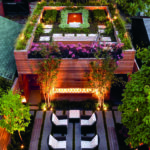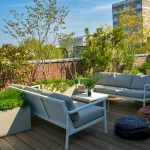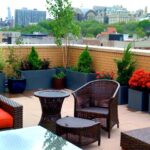A roof garden is a type of garden that is located on the roof of a building. It is a great way to utilize unused space and create a beautiful and functional outdoor area. Roof gardens can be designed in a variety of styles, from sleek and modern to lush and tropical. The key to a successful roof garden design is to carefully consider the space available, the climate, and the desired aesthetic.
One of the most important factors to consider when designing a roof garden is the weight load that the roof can support. It is essential to have a structural engineer assess the roof before starting any garden design project. This will ensure that the roof can safely support the weight of the soil, plants, furniture, and any additional features such as water features or decking.
Another important aspect of roof garden design is choosing the right plants. Since roof gardens are exposed to more intense sunlight, wind, and temperature fluctuations, it is crucial to select plants that are hardy and drought-resistant. Succulents, grasses, and herbs are excellent choices for roof gardens, as they require less water and maintenance than other plants. To add visual interest, consider planting a mix of different textures and colors.
Incorporating seating and outdoor furniture into the design of a roof garden can transform it into a true outdoor oasis. Built-in benches, lounge chairs, and dining sets can all help create a comfortable and inviting space for relaxation and entertaining. Additionally, adding elements such as umbrellas, shade sails, or pergolas can provide much-needed shade during the hot summer months.
Water features can also be a stunning addition to a roof garden design. Fountains, ponds, or birdbaths can provide a focal point and help create a sense of tranquility in the outdoor space. Water features can also attract birds, butterflies, and other wildlife, adding to the overall appeal of the garden. However, it is crucial to ensure that water features are properly installed and maintained to prevent leaks or structural damage.
Finally, lighting is an essential element in roof garden design. Strategic placement of lights can help create a warm and inviting atmosphere in the evenings. Consider incorporating solar-powered lights, string lights, or lanterns to illuminate pathways, seating areas, and planters. Lighting can also help extend the use of the roof garden into the evening hours, allowing for more enjoyment of the space.
















